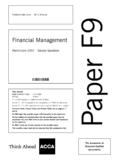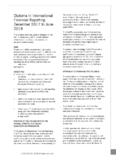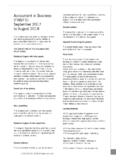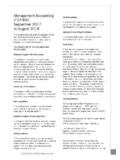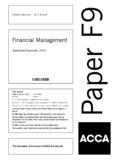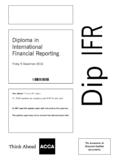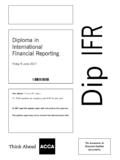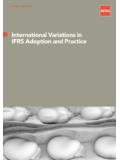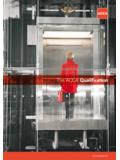Transcription of relevant to CAT Paper 8 (UK) and (INT) and ACCA ...
1 42 student accountant February 2008technicalrisk The approach adopted by an audit firm to a specified audit assignment will be a key factor in determining the outcome of the audit. If auditors fail to adopt the correct audit approach then the likelihood of audit failure increases, failure which could lead to a damaged reputation and potentially costly litigation against the firm. This article is the first of a series on risk based auditing and audit APPROACHESE ssentially there are four different audit approaches: the substantive procedures approach the balance sheet approach the systems-based approach the risk-based substantive procedures approachThis is also referred to as the vouching approach or the direct verification approach. In this approach, audit resources are targeted on testing large volumes of transactions and account balances without any particular focus on specified areas of the financial balance sheet approach In this approach, substantive procedures are focused on balance sheet (statement of financial position) accounts, with only very limited procedures being carried out on income statement/profit and loss account items.
2 The justification for this approach is the notion that a risk-based approach to auditing financial statementsrelevant to CAT Paper 8 (UK) and (INT) and acca Qualification Papers F8 and P7 (UK) and (INT)if the relevant management assertions for all balance sheet (statement of financial position) accounts are tested and verified, then the profit/loss figure reported for the accounting period will not be materially misstated. The systems based approach This approach requires auditors to assess the effectiveness of the internal controls of an entity, and then to direct substantive procedures primarily to those areas where it is considered that systems objectives will not be met. Reduced testing is carried out in those areas where it is considered systems objectives will be met. The risk based approachIn this approach, audit resources are directed towards those areas of the financial statements that may contain misstatements (either by error or omission) as a consequence of the risks faced by the A RISK BASED APPROACHG iven the nature of the audit process, every audit assignment presents a different challenge to an audit firm, with no two audit assignments being the same.
3 For example, no two entities are the same in terms of business sector, location, size, employees, governance issues, ethos, and complexity of operations. There is no one single approach to auditing which ensures the performance of a perfect audit. However, it is generally accepted that for most entities of size, the risk-based audit approach will minimise the possibility of audit objectives not being met. Consequently ISA 315, Identifying and Assessing the Risks of Material Misstatement Through Understanding the Entity and its Environment (Redrafted)1, compels auditors to adopt a risk-based approach to audits. In so doing, it requires auditors to make risk assessments of material misstatements at the financial statement and assertion levels, based on an appropriate understanding of the entity and its environment, including internal controls. Students should be familiar with assertions made by management, as described in ISA 500, Audit Evidence2, and these will be covered in a separate the auditor is required to focus on the entity and its environment when making risk assessments, this is known as the top down approach to identifying risks, and students should become familiar with this term.
4 The word top refers to the day-to-day operations of the entity and the environment in which it operates; down refers to the financial statements of the entity. In summary, this approach requires auditors to identify the key day-to-day risks faced by a business, to consider the impact these risks could have on the financial statements, and then to plan their audit procedures accordingly. For this reason, the approach is often referred to as the business risk approach . When adopting this approach, in order to with detailed control activities and systems objectives in assessing the control risk for a specified area of the financial statements. It is important to appreciate that the auditor has no control over the extent of either inherent or control risk; these are risks borne by the entity subject to audit. However, the auditor has to assess them in the process of determining the extent of the detailed substantive procedures to be carried out.
5 Detection risk This is simply the risk that the auditor s procedures will not detect a misstatement that exists in an assertion that could be material (individually or when aggregated with other misstatements). Given that auditors use their judgement in determining levels of applicable inherent risk and control risk, clearly the auditor s input does impact on the level of detection risk allowed. In fact, auditors manage the overall level of audit risk that they are prepared to accept on a given audit assignment by not only determining the nature and extent of the procedures and testing to be carried out, but also by allocating an appropriate level of audit resource to the AUDIT RISK MODELThe formula for the audit risk model is:Audit risk = Inherent risk x Control risk x Detection risktechnicalfacilitate the identification of risks and the assessment of their effect on the financial statements, risks are categorised as: financial risks such as cash flow risks compliance risks such as breaching of laws and regulations risk operational risks such as loss of key employee risk and loss of data risk.
6 Specific use of the business risk approach to an audit will be covered in the second article of this series. The ultimate objective of adopting the business risk approach is to reduce audit risk the risk that the auditor will give an inappropriate opinion on the financial statements. Students should therefore appreciate how business risk is linked to audit risk and how the business risk approach is integral to the use of the audit risk model when planning audit work. FINANCIAL STATEMENT/DETECTION RISKS tudents should be aware that audit risk is a function of financial statement risk (the risk that the financial statements are materially misstated), and detection risk (the risk that the auditor will not detect such misstatements). Financial statement risk This has two components inherent risk and control risk is the susceptibility of an assertion to a misstatement which could be material (individually or when aggregated with other misstatements), assuming that there were no related internal controls.
7 It is limited either to the nature of the item in the financial statements under review, such as a provision which is estimated, or the nature of the entity and the industry in which it operates (for example a retail chain in the fashion industry). A top down business risk approach will be particularly pertinent when identifying inherent risks falling into the latter risk is the risk that a misstatement that could occur in an assertion and that could be material individually or when aggregated with other misstatements will not be prevented or detected and corrected on a timely basis by the internal control. Auditors consider the control environment of an entity together February 2008 student accountant 43 From the above, it is apparent that if risk percentage values can be assessed for both inherent risk and control risk, then for a desired level of (acceptable) audit risk, a prescribed level of detection risk can be set and thus the extent of required substantive procedures can be determined.
8 For example, if an audit firm works to a desired audit risk level of 5%, then for a given area of the financial statements where inherent risk and control risk factors have been assessed as 80% and 25% respectively, the required level of detection risk would need to be set at 25% (ie = x x ). Remember, the higher the level of prescribed detection risk then the lower the level of substantive procedures and audit resources, and vice-versa. Irrespective of the level at which audit risk is set, detection risk has an inverse relationship with financial statement risk the lower the financial statement risk then the higher the detection risk and consequently, the lower the level of detailed testing required. It should be noted that once the prescribed level of detection risk has been set, audit firms may use manual tables as a guide to the size of samples to be tested, or particularly for larger and more complex audits will use dedicated computer software.
9 CONCLUSIONH aving set out the fundamental points of a risk-based approach to auditing, the second article in this series will cover various aspects of audit planning and documentation where a risk-based approach has been adopted. NOTES1 In the UK, refer to ISA 315 (UK and Ireland), Obtaining an understanding of the entity and its environment and assessing the risks of material In the UK, refer to ISA 500 (UK and Ireland), Audit Pine is examiner for CAT Paper 8
